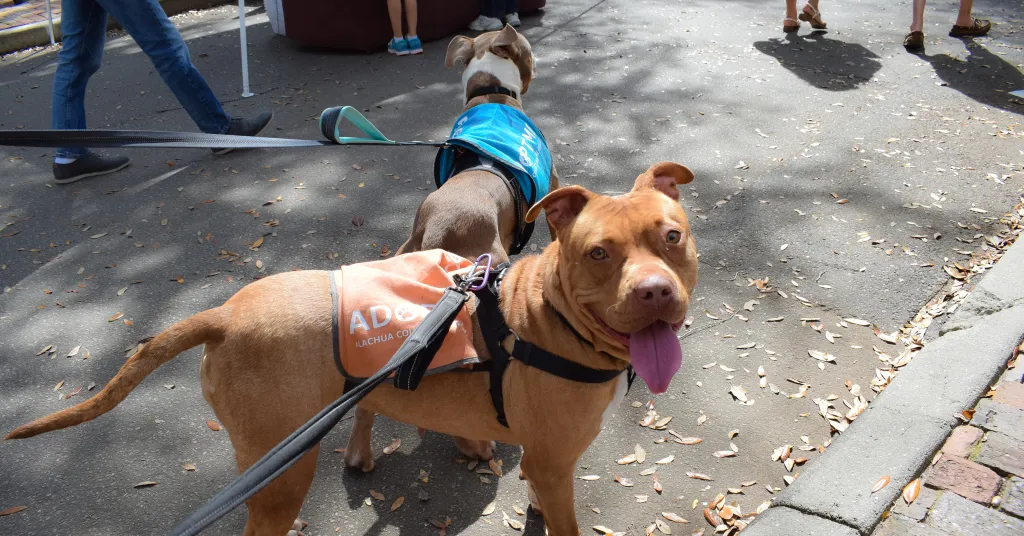Leash training is an essential part of raising a well-behaved and obedient Pitbull. Proper leash training ensures your dog can walk safely and comfortably in various environments, making walks enjoyable for both of you.
This guide covers everything you need to know about Pitbull leash training, from choosing the right equipment to step-by-step training techniques.
Why Leash Training is Important
Leash training your Pitbull is crucial for several reasons:
- Safety: Prevents your dog from running into dangerous situations.
- Control: Helps manage your dog’s behavior in public spaces.
- Exercise: Ensures your Pitbull gets the physical activity they need.
- Bonding: Strengthens the bond between you and your dog through consistent training.
Choosing the Right Equipment
- Collar or Harness: Decide whether to use a collar or a harness. A harness can be more comfortable and provide better control, especially for strong dogs like Pitbulls. Ensure it fits snugly but not too tight.
- Leash: Use a sturdy, non-retractable leash, typically 4-6 feet long. This length provides control without giving too much freedom.
- Treats and Rewards: Have high-value treats on hand to reward your Pitbull for good behavior during training.
Step-by-Step Leash Training
Step 1: Getting Acquainted with the Leash
- Introduce the Leash: Allow your Pitbull to sniff and explore the leash and collar/harness. Let them get used to the sight and smell.
- Attach the Leash Indoors: Attach the leash to your dog’s collar or harness and let them drag it around indoors. Supervise to ensure they don’t get tangled or scared.
- Positive Reinforcement: Praise and reward your dog for calmly accepting the leash.
Step 2: Basic Commands
- Sit and Stay: Teach your Pitbull basic commands like sit and stay. These commands form the foundation for successful leash training.
- Practice Indoors: Practice walking on the leash indoors, using treats and praise to encourage your dog to follow you.
Step 3: Controlled Outdoor Walks
- Short Walks: Start with short walks in a quiet, familiar area. Keep the sessions brief to avoid overwhelming your dog.
- Loose Leash Walking: Encourage your dog to walk beside you on a loose leash. Use treats and praise to reward them for staying by your side.
- Stop and Go: If your Pitbull pulls, stop walking and wait for them to return to your side. Reward them and resume walking. This teaches your dog that pulling won’t get them where they want to go.
Step 4: Gradual Increase in Difficulty
- Longer Walks: Gradually increase the duration and distance of your walks as your dog becomes more comfortable with leash walking.
- New Environments: Introduce new environments slowly. Start with quiet areas and gradually expose your dog to busier locations.
- Distractions: Practice leash training in the presence of distractions like other dogs, people, and cars. Use high-value treats and consistent commands to maintain your dog’s focus.
Common Challenges and Solutions
- Pulling on the Leash: Stop and wait for your dog to return to your side before continuing. Consistency is key to breaking the pulling habit.
- Lunging or Barking: Use the sit and stay commands to regain control. Reward your dog for calm behavior. Consider working with a professional trainer if the behavior persists.
- Fear or Anxiety: If your Pitbull shows signs of fear or anxiety, take a step back and reintroduce the leash more slowly. Use positive reinforcement to build confidence.
Advanced Training Techniques
- Heel Command: Teach your dog to walk directly beside you on command. Use treats and praise to reinforce this behavior.
- Changing Directions: Frequently change directions during walks to keep your dog focused on you. Reward them for following your lead.
- Training Classes: Enroll in a professional obedience class for additional guidance and socialization opportunities.
Maintaining Good Leash Behavior
- Consistency: Be consistent with commands and rewards. Regular practice reinforces good behavior.
- Regular Exercise: Ensure your Pitbull gets enough physical and mental exercise. A tired dog is less likely to exhibit problematic behavior on walks.
- Positive Reinforcement: Continue using positive reinforcement throughout your dog’s life. Praise and rewards encourage ongoing good behavior.
Conclusion
Leash training your Pitbull is an essential part of responsible dog ownership. With patience, consistency, and positive reinforcement, you can teach your dog to walk calmly and confidently on a leash.
This not only ensures their safety but also makes walks an enjoyable and bonding experience for both of you. Remember, the key to successful leash training is to make it a positive and rewarding experience for your Pitbull.


Leave a Reply